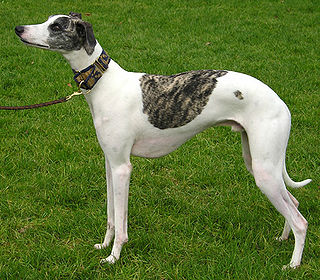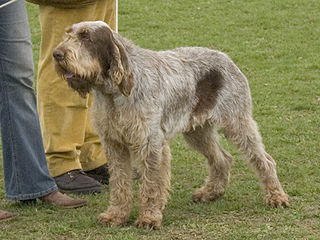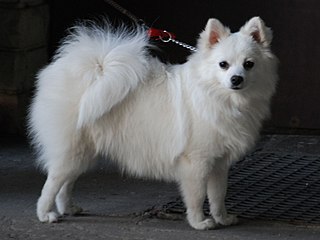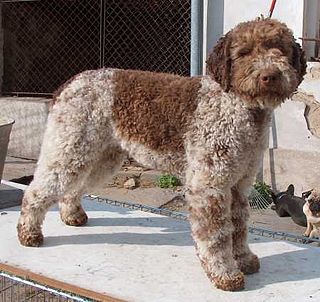
The Ibizan Hound is a lean, agile dog of the hound family. There are two hair types of the breed: smooth and wire. The more commonly seen type is the smooth. Some consider there to be a third type, long, but the longhair is most likely a variation of the wire.

The Italian Greyhound is an Italian breed of small sighthound. It may also be called the Italian Sighthound.

Sighthounds, also called gazehounds, are a type of dog, hounds that hunt primarily by sight and speed rather than by scent and endurance as scent hounds do.

The Pharaoh Hound or Kelb tal-Fenek is a Maltese breed of hunting dog. It is traditionally used for rabbit-hunting in the rocky terrain of the islands; the Maltese name means "rabbit dog".

The Bergamasco Shepherd, Italian: Cane da Pastore Bergamasco, is an Italian breed of sheepdog. It originated in the Alpi e Prealpi Bergamasche, where it was used as a herding dog for both sheep and cattle.

The Spinone Italiano is an Italian breed of hunting dog, traditionally used for tracking, for pointing and for retrieving game.

The Cane Corso is an Italian breed of mastiff. It is usually kept as a companion dog or guard dog; it may also be used to protect livestock. In the past it was used for hunting large game, and also to herd cattle.

The Volpino Italiano or Volpino is an Italian breed of dog of Spitz type. It is closely related to the Pomeranian and to the German Spitz.

The Lagotto Romagnolo is an Italian breed of dog. It originates in the marshlands of the Delta del Po in the eastern part of the Romagna sub-region of Italy. The name derives probably from the term “lagotto” which is the name of the inhabitants of the local town of Lagosanto. Another theory believes it comes instead from Romagnol can lagòt, meaning "water dog". Its traditional function was as a gun dog, specifically a water retriever; since the drainage of large areas of wetland habitat in its area of origin, it is now more often used to hunt for truffles.

The Bracco Italiano is an Italian breed of pointing dog.

The Segugio Italiano is either of two Italian breeds of dog of scent hound type, the wire-haired Segugio Italiano a Pelo Forte or the short-haired Segugio Italiano a Pelo Raso. Apart from the coat type, they are closely similar, and in some sources may be treated as a single breed; the Fédération Cynologique Internationale and the Ente Nazionale della Cinofilia Italiana treat them as separate. They are also genetically close to the other two Italian scent hound breeds, the Segugio Maremmano and the Segugio dell'Appennino. They are traditionally used for hunting hare, but may also be used in boar hunts.

Podenco Canario is a breed of dog from the Canary Islands. The Podenco Canario is still used today, primarily in packs, most often for the sport hunting of rabbits. The word "podenco" in Spain refers to a certain type of dog, typically rabbit hunters with the same body shape. "Canario" is a reference to its region of origin, the Canary Islands. The Spanish Kennel Club, Real Sociedad Canina de España, recognises the following similar dog breeds that use the identifier "podenco" in their names: Podenco Andaluz, Podenco Ibicenco, and Podenco Valenciano. ge

The Neapolitan Mastiff or Mastino Napoletano is an Italian breed of large dog of mastiff type. It descends from the traditional guard dogs of central Italy. It was recognised as a breed by the Ente Nazionale della Cinofilia Italiana in 1949, and accepted by the Fédération Cynologique Internationale in 1956.

The Appenninica is a modern breed of sheep from the central Apennine mountains of Italy. It is raised principally in Tuscany and Umbria, but also in Abruzzo, Emilia–Romagna, Lazio, the Marche and Campania. The breed was created in the 1970s by cross-breeding and subsequent selection of local breeds such as the Bariscianese, the Casentinese, the Chietina Varzese, the Pagliarola, the Perugina del piano, the Pomarancina, the Senese delle Creti and the Vissana with Bergamasca rams and with the French Ile-de-France and Berrichon du Cher, with the aim of increasing the meat yield. The breed was recognised in 1980 and a herdbook established in 1981. Although this is a medium-coarse wool breed, it is raised primarily for meat.
The Segugio dell'Appennino or Piccolo Lepraiolo Italiano is an Italian breed of small scenthound, bred specifically to hunt hare. It may be either smooth-haired or wire-haired. It is one of four Italian breeds of scenthound, the others being the Segugio Italiano a Pelo Forte, the Segugio Italiano a Pelo Raso and the Segugio Maremmano. It received full recognition from the Ente Nazionale della Cinofilia Italiana in 2010; it is not recognised by the Fédération Cynologique Internationale.

The Segugio Maremmano is an Italian breed of scent hound from the coastal plains of the Maremma, in Tuscany. It is mainly used for hunting wild boar, but may also be used to hunt hare and other mammals. They may be either smooth-haired or rough-haired.

The Ente Nazionale della Cinofilia Italiana, usually known as the ENCI, is the national organisation responsible for the recognition, standardisation and registration of pedigree dogs in Italy. It is sometimes called the Italian Kennel Club.

The Nero Siciliano is a breed of domestic pig from the Mediterranean island of Sicily, in southern Italy. It is raised mainly in the province of Messina, particularly in the Monti Nebrodi. For this reason it is often known as the Nero dei Nebrodi; it may also be called Nero delle Madonie or Nero dell'Etna, for its association with the Madonie mountains and mount Etna respectively. It is one of the six autochthonous pig breeds recognised by the Ministero delle Politiche Agricole Alimentari e Forestali, the Italian ministry of agriculture and forestry.

The Pastore della Lessinia e del Lagorai is an old Italian dog breed from the northeastern region called Triveneto. It is not recognized by any major kennel organisation.


















